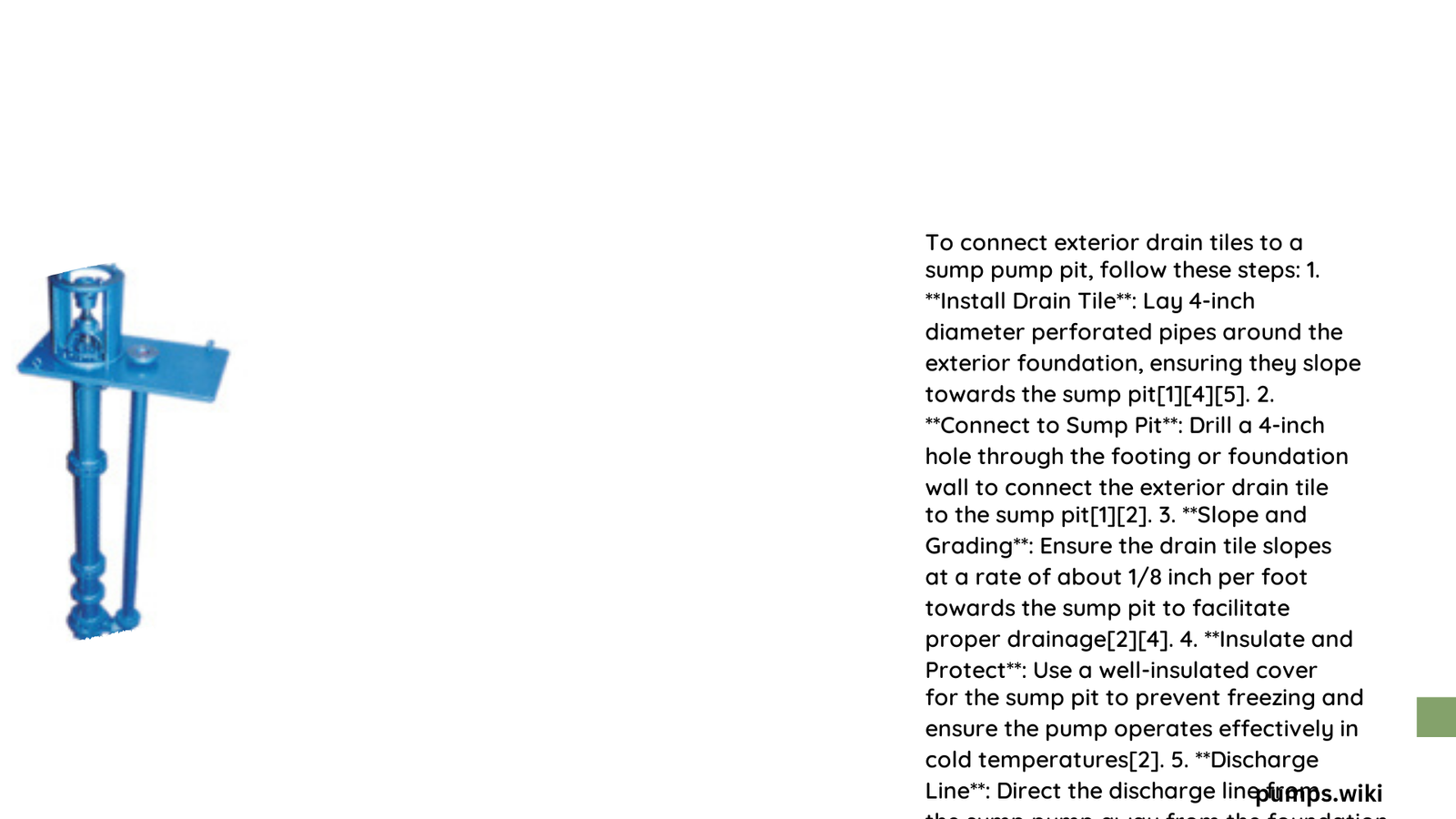Exterior drain tiles emptying to sump pump pit are an essential component of a home’s water management system. This setup involves a network of perforated pipes installed around the foundation’s perimeter, collecting excess groundwater and directing it to a sump pump pit. From there, the water is pumped away from the house, preventing basement flooding and foundation damage. This system is crucial for maintaining a dry basement and protecting the structural integrity of your home.
What Are the Key Components of an Exterior Drain Tile System?
An exterior drain tile system consists of several critical components:
- Perforated pipes (drain tiles)
- Gravel bed
- Filter fabric
- Sump pump pit
- Sump pump
Each of these elements plays a vital role in the efficient operation of the system. The perforated pipes collect water, the gravel bed facilitates drainage, the filter fabric prevents clogging, and the sump pump pit and pump work together to remove the collected water from your home’s foundation area.
How Does the Installation Process Work?

The installation of exterior drain tiles emptying to a sump pump pit involves several steps:
- Site assessment and planning
- Excavation around the foundation
- Laying of gravel bed
- Installation of perforated pipes
- Covering pipes with more gravel and filter fabric
- Connection to the sump pump pit
- Backfilling and grading
This process requires careful planning and execution to ensure proper water flow and system efficiency.
What Are the Best Materials for Exterior Drain Tiles?
Choosing the right materials is crucial for the longevity and effectiveness of your exterior drain tile system. Here’s a table outlining the best materials and their characteristics:
| Material | Characteristics | Recommended Use |
|---|---|---|
| PVC Pipes | Durable, resistant to corrosion | Main drain tiles |
| Corrugated Plastic | Flexible, easy to install | Alternative to PVC in some cases |
| Gravel (1/2 to 3/4 inch) | Promotes drainage, prevents clogging | Surrounding drain tiles |
| Filter Fabric | Prevents soil infiltration | Wrapping around gravel and pipes |
How to Ensure Proper Slope for Effective Drainage?
Proper slope is essential for the effective operation of exterior drain tiles. Here are key points to consider:
- Aim for a minimum slope of 1/8 inch per foot
- Use a laser level for accurate grading
- Ensure consistent slope towards the sump pump pit
- Avoid low spots or dips in the pipe run
Proper sloping allows gravity to assist in water flow, reducing the workload on your sump pump and improving overall system efficiency.
What Are the Common Challenges in Maintaining Exterior Drain Tiles?
Maintaining exterior drain tiles can present several challenges:
- Clogging from soil and debris
- Root intrusion from nearby plants
- Pipe damage due to settling or freezing
- Sump pump failure
- Inadequate slope leading to poor drainage
Regular inspections and maintenance can help identify and address these issues before they become major problems.
How Does Soil Type Affect Exterior Drain Tile Performance?
Soil type plays a significant role in the performance of exterior drain tiles:
- Clay Soil: Poor drainage, may require additional measures
- Sandy Soil: Good drainage, but may need extra filtration
- Loamy Soil: Balanced drainage, generally ideal for drain tiles
- Rocky Soil: Can damage pipes, may require special installation techniques
Understanding your soil type is crucial for designing an effective drain tile system tailored to your property’s specific needs.
What Is the Optimal Sump Pump Pit Configuration?
The sump pump pit is a critical component of the exterior drain tile system. Here are key considerations for optimal configuration:
- Size: Typically 18-24 inches in diameter and depth
- Location: Lowest point of the basement or crawlspace
- Material: Durable plastic or concrete
- Cover: Airtight to prevent radon gas infiltration
- Pump Capacity: Matched to expected water volume
A properly configured sump pump pit ensures efficient water removal and protects your home from potential flooding.
How to Choose the Right Sump Pump for Your System?
Selecting the appropriate sump pump is crucial for the effectiveness of your exterior drain tile system. Consider the following factors:
- Pumping capacity (gallons per hour)
- Head pressure (vertical pumping distance)
- Switch type (float switch vs. pressure switch)
- Backup power options
- Durability and warranty
Choose a pump that can handle the expected water volume and has features that suit your specific needs and local conditions.
What Are the Best Practices for Long-Term Maintenance?
To ensure the longevity and efficiency of your exterior drain tile system:
- Conduct annual inspections of the entire system
- Clean the sump pump pit regularly
- Test the sump pump quarterly
- Clear any visible debris from drain tile openings
- Monitor for signs of water issues in the basement
- Consider professional maintenance every 3-5 years
Following these practices will help prevent system failures and extend the life of your exterior drain tiles and sump pump.
How Do Environmental Factors Impact System Design?
Environmental factors significantly influence the design of exterior drain tile systems:
- Rainfall Patterns: Determine required capacity
- Frost Depth: Affects installation depth
- Groundwater Levels: Influences system layout
- Topography: Impacts drainage patterns and pump requirements
- Local Regulations: May dictate specific design features
A well-designed system takes these factors into account to provide optimal performance in your specific environment.
By understanding these aspects of exterior drain tiles emptying to sump pump pit, homeowners can better maintain their systems and protect their properties from water damage. Regular maintenance, proper installation, and attention to environmental factors are key to ensuring the long-term effectiveness of this crucial home water management system.
References:
1. https://www.rubi.com/us/blog/drain-tile-installation/
2. https://basc.pnnl.gov/resource-guides/footing-drain-pipe
3. https://budgetdry.com/2015/02/17/exterior-drain-tile-installation-the-basics/
